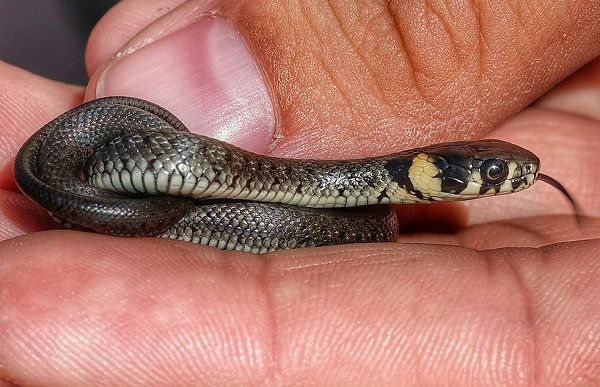European Grass Snake: Nature & Lore
- Sylvia Rose

- May 11, 2024
- 5 min read
Updated: May 26, 2024
Snakes have mystic associations since the beginning of human thought. The European Grass Snake (Natrix natrix) is a small, harmless reptile common through Europe. In folklore it's a symbol of fertility and earth mysteries, and a benevolent house or nature spirit.
READ: Cult of the Fire God - Bronze Age Quest Adventure
The European grass snake is sometimes called the green snake or ringed snake. Its color can vary from grey to brown to green tones to almost teal blue. Natrix natrix has a light-colored collar, seen yellowish in the snake above.
READ: Cult of the Fire God - Bronze Age Quest Adventure
In spirituality the snake is a strong fertility symbol. It's depicted in the art of ancient civilizations such as Egypt, Rome and the Minoans, and continues to have vital meaning today. In spring, mating balls of snakes resemble the multi-headed serpents of myth.
Semi-aquatic reptiles, European grass snakes spend much of their time in water or moist places where amphibian prey is to be found. Like frogs, snakes are indicators of environmental health.
READ: Lora Ley Fantasy Fiction - German Mythology Adventures
A frog breathes through its skin and is highly sensitive to water-borne pollutants. No frogs means no Natrix natrix, and a sign of poor water or environmental quality, as they're all part of the same ecosystem.
Snakes in spirituality relate to:
fertility
powers of creation
mystery, secrets
rebirth
cycles
the Sun
sensuality
seduction
intuition; dreams (especially water snakes)
wealth, prosperity
health, medicine
cunning; wisdom
trickery
prophecy, divination
In Hinduism, the serpent represents Kundalini energy, coiled at the base of the spine. It waits to be awakened to achieve spiritual enlightenment.
Snakes are used during the Roman period to control rodents. Lares, or household gods, can be portrayed as snakes. In Baltic folklore, the grass snake or žaltys is a house spirit. It lives in the house with the humans, often resting by the hearth where it's warm.
READ: Cult of the Fire God - Bronze Age Quest Adventure
The žaltys snake is sacred to sun goddess Saulė. If it's seen in the field, people try to make friends with it, traditionally by giving it a bowl of milk. Snakes don't drink milk, being unable to digest it, but grass snakes easily acclimatize to humans. Killing the žaltys is very bad luck.
In ancient Greece, snakes are considered guardians of the Underworld. Living in cracks and holes in the earth they act as messengers between Upper and Lower worlds. According to Plato, the snake "eating its own tail", or Ouroboros symbol, represents eternal life.
READ: Reiker For Hire - Victorian Detective Murder Mysteries
The ouroboros is also one of the most familiar signs of alchemy, relating wholeness, healing and immortality. An exception is the Germanic Lindwyrm, who puts tail in mouth and rolls like a wheel to pursue human prey.
In legend the snake is an ancient form of dragon, the Worm or Wyrm, such as the German Lindwyrm. The Lindwyrm has very small legs or none at all. It's a beast of enormous capacity. Lindwyrm tricks humans into its jaws by pretending to be part of the environment.
READ: Lora Ley Fantasy Fiction - German Mythology Adventures
Any treasure the Lindwyrm lies upon increases, associating dragons with hoards of wealth. While the grass snake doesn't display this talent, all snakes relate to prosperity.
European grass snakes are darker in colder habitats. The black and white pattern on the underside of N. natrix is different for each and can identify individual snakes. Although grass snakes are non-venomous and don't bite even for fun, they're distantly related to cobras.
READ: Cult of the Fire God - Bronze Age Quest Adventure
The throwback shows in some individuals having a partial hood or thickened skin they can flex if confronted. This small snake species has a number of predators such as corvids, storks, owls, hawks, foxes and domestic cats.
A snake sheds its skin at least once a year, possibly more often depending on the species. The eyes look milky blue at this time and the snake is vulnerable, but also more aggressive or reactive if threatened. If caught it might vomit out its stomach contents.
READ: Reiker For Hire - Victorian Detective Murder Mysteries
Natrix natrix releases a foul odor and has the ability to "play dead" or go completely limp when frightened. It might bleed from the nose or mouth but isn't actually injured. The animal stays conscious but in a state of thanatosis (named for Greek Thanatos, god of death).
In one season grass snakes need to eat at least three times. Besides hunting, the snake basks to absorb warmth from sunlight. In spring, males emerge first to gather energy for romance, which happens as soon as the female snakes come out of the ground.
READ: Lora Ley Fantasy Fiction - German Mythology Adventures
She'll lay 10 - 40 soft-shelled eggs in June - July, often in compost heaps or rotting vegetation which gives off heat. In 10 weeks the young hatch, and are immediately self-sufficient.
Grass snakes are typically slim, and grow to about 1 m (3 ft 3 in). The grass snake is widely distributed in mainland Europe, ranging from mid Scandinavia to south Italy. It's also found in the Middle East and northwest Africa.












